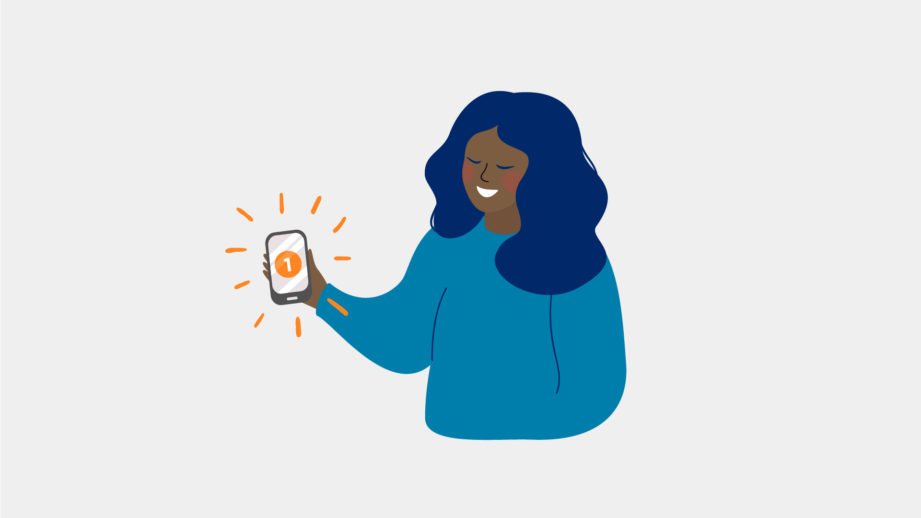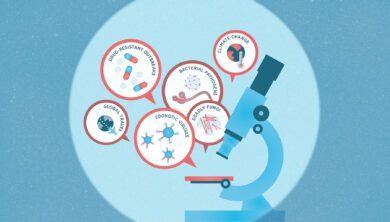
How ‘Get Updates on COVID-19’ Got Up and Going
by Kathryn MayAs Canada locked down to battle the deadly coronavirus, Pascale Elvas dug into the data and found 90% of the millions of Canadians visiting the federal government’s website were looking for trustworthy information about the new infectious disease.
By time the COVID-19 outbreak hit, misinformation was rampant—spread both deliberately and by the well-intentioned. Stories of conspiracy theories, fake cures and preventions were up against the accurate information governments and health authorities were racing to get out to the public.
The federal government knew there was a huge information void to fill. If it couldn’t get reliable information to Canadians fast, the misinformation flooding the internet would fill the gap.
That led to the creation of a new email notification service, Get Updates on COVID-19, which turns traditional methods of government communications on its ear. It gives Canadians the COVID-19 information they’re seeking, right away, not what the government wants to announce or promote on its schedule.
“It had to be apolitical and non-promotional,” said Elvas, the director who led the team that put the email notification service together.
“We track what topics are top-of-mind for Canadians on any given week, which varies vastly,” she said. “We tailor the content to the top searches, which is a very different way of doing communication. Instead of focusing on government news and making announcements, we respond to what people want.”
The approach is a recognition of how different COVID-19 was from other pandemics. The virus was new and researchers were learning about it on the fly. People were anxious, afraid and hungry for reliable information. At the same time, the world had never been so swamped with information, reliable and otherwise, that spread as fast as the virus in ever-connected social networks.
The World Health Organization called it an “infodemic,” the abundance of information that “makes it hard for people to find trustworthy sources and reliable guidance when they need it.”
Marcel Saulnier, Assistant Deputy Minister at Health Canada, said the government was gearing up its response to the global spread of the virus, when “all hell broke loose” in mid-March. The community spread of the disease took hold and the country shut down. The Canada.ca website had never seen so much traffic, inundated with up to 13 million visits a day.
Health Canada’s Deputy Minister Stephen Lucas, who headed the government’s COVID-19 task force, had created a separate COVID secretariat within the department with “special purpose teams” to flesh out its response.
Communication was key. Governments are no match for the influencers who know how to hype content and make it go viral in the internet era. They needed a special team of digital experts. who know all about data analytics, platforms, apps and being flexible, to help disperse the latest public health advice.
That’s when Elvas stepped in. A Senior Director at the Treasury Board Secretariat, she was one of 300 bureaucrats who answered Health Canada’s call to temporarily join their team to work on the pandemic. She started the job March 17 and the next day pitched a bare-bones proposal for a subscription-based email notification service to her new bosses Saulnier and Lucas. They approved it within days.
“The central vision was this is not a propaganda machine, but a service to the public,” said Saulnier.
“It was not to bombard people with information, but selectively give them important nuggets, whether about wearing masks, physical distancing or how to prepare food and protect your family. That’s the bread and butter issues people need to care about and the kind of information they would benefit from. That was the vision.”
And that vision became the heart of the “Standard Operating Procedure” Lucas approved for the project to begin—and the touchstone whenever the principles of that vision were challenged.
“So often we build a thing, then go ask the experts to see if it complies. The experts ask for changes. It’s back to product owners for changes and this is done again, whether for privacy, security and legal. We brought everyone together at the outset to build it together.” – Brian Enright, Director, Canadian Digital Service
In many ways, Elvas was the right person at the right time. She’s digital literate or savvy, a proponent of digital government and comfortable with the latest digital tools and their possible uses. She earned her digital chops working on Blueprint 2020, a 2013 plan to modernize the public service and bring it into the digital age. She was also one of the founding members of the government’s digital swat team, known as the Canadian Digital Service.
She came up with the idea for the notification service when data revealed 90 per cent of the millions visiting Canada.ca came from Google. That told her they were looking to the government as the trusted source of information. (That was further borne out when the service later installed a feedback form and 66% of subscribers said they liked the service as a credible source and 75% signed up to specifically get the government’s information on COVID.)
The first hurdle was getting the authority to gather the email addresses of Canadians. That was covered by the Department of Health Act, which allows the collection of data to reduce the spread of the communicable disease. This made Health Canada the service’s “business owner” and responsible for the privacy of email addresses collected.
Next came the assembly of a multidisciplinary team—all working remotely during the lockdown—with experts from Health Canada, Service Canada, the Canadian Digital Service and Treasury Board Secretariat.
They all got in on the ground floor: developers and coders were joined by security, privacy, legal, and accessibility experts—who are typically brought in one-by-one to check for compliance after a model is built. They followed all the normal rules, steps and guidance from authorities, but telescoped the process and decision-making into days by having everyone at the table from the start.
“What’s really magical about this project was the way everyone built this together and very fast,” said the Digital Academy’s at the Canadian Digital Service’s (CDS) Director Brian Enright, who headed the service’s rollout strategy. “We launched the service in under two weeks, and used data to drive business decisions to grow subscribers and ensure content was what Canadians were looking for.”
“So often we build a thing, then go ask the experts to see if it complies. The experts ask for changes. It’s back to product owners for changes and this is done again, whether for privacy, security and legal. We brought everyone together at the outset to build it together.”
The team had a head start because CDS had recently created Notify, an email notification platform for departments that was built on the open source code that the UK used to build a similar platform, also called Notify.
The UK had built and used its Notify platform for three years so the bugs were worked out and the back-end “well thought-out and developed,” said Bryan Willey, CDS’s Product Manager of Notify. Some federal departments were already using it. None, however, had yet to use it to deliver more than 30,000 email notifications.
With Notify as the base, the service could be up and running within days, use the cloud, cost next to nothing and, if the service took off, could pump out millions of messages a day.
The front end, however, needed work. It had to be adapted for Canada so it could deliver notifications in English and French and in six time zones and meet federal accessibility standards. The platform’s capacity was expanded and tested so the service could deliver up to 10 million notifications a day if needed.
“Think of it like this,” said Willey. “We were able to copy and paste a house that took the UK three years to build. It had a strong foundation, walls and solid structure, but we had to change the curtains and furniture and get a new address on a street in Canada. We already had a nice, sturdily-built house and we put a Canadian flag on it.”
Service Canada, which runs the government’s Canada website and social media platform, stepped up and used its existing canada.ca infrastructure to securely manage the data and create the front-end subscription form where people could sign up for notifications. It did all the behind-the-scenes work and implemented the application programming interface that connected the Notify platform with Canada.ca.
Service Canada built the web pages that allowed the public to subscribe, submit requests, confirm emails, unsubscribe and send in feedback. The first of the 18 web pages went live in late March to test the sign-up process and other features were added later.
“I can’t emphasize enough about how much collaboration was the strength of this project,” said Service Canada’s Melissa Teasdale.
“Pascale had the idea; Health Canada had the information to create the authoritative content to be sent out; CDS had mechanisms to send email notifications and I had the web platform to create the subscription service … We all had to come together to build an end-to-end product. We each had a piece and none of us could have done it alone.”
Those pieces quickly fell in place.
First, the content had to be evidence-based, national in scope and focus on what users want. The team didn’t want to bombard Canadians with information every time the website was updated, which could be a few times a day, and leave subscribers to figure out what was new. It had to be targeted.
The UK, for example, used Notify for a similar service which sent subscribers automated messages whenever its COVID-19 web pages were updated. It was left to the subscribers to figure out what information was new. Still, more than 95,000 people quickly signed up.
Canada’s team decided that approach wasn’t giving people the information they wanted. Instead, they tracked the top searches on the government’s coronavirus website and what callers were asking on the 1-833 COVID hotline. They tailored the notification to the top topics—which differed from day to day—and emailed them to subscribers with links to the up-to-date information that the government had published on those questions.
“We were data driven. This isn’t a newsletter focused on government needs, which like a megaphone tells what government wants to push out to people. We have a service based on the users’ needs,” said Elvas.
The messages had to be simple, concise, easy to read—written at Grade 8 level—in both English and French, and accessible. They would link only to content already publicly available on government websites. They opted for a web-based service so notifications are readable from any device.
Saulnier said the crisis drove home the need to work quickly, collaboratively and gave the team “the license to take risks.” He trusted the team and its understanding of the “go and no-go zones” leaving him as “part messenger, leader and interlocutor with the deputy minister and minister offices to keep them in the loop” as the service evolved.
“I didn’t do a lot of heavy lifting for this,” he said. “The team did all the work and I ran interference where needed or helped make connections where helpful. The team came from outside the department and didn’t know people in the department. I helped with relationships with the communications branch, and the folks in privacy and security.”
Saulnier was sent short daily updates—not long briefing notes—on what they did that day and plans for the next. They flagged any “blockers or concerns that could shut us down” and Saulnier cleared the way, said Enright. He assumed the risk with assurances to the team that “we have DM approval” so plow ahead.
In a space of two weeks, a prototype or “alpha” version was ready and the first notification sent. There were no real subscribers at first. A batch of public servants volunteered with their emails to test drive the service.
Deputy Minister Lucas’s approval included a soft launch of the service in phases to test, gather data and refine along the way.
A preview of the basic service—with “minimal functionality” —was quietly released on April 2. Subscription links were added to the less visited COVID pages to keep the number of possible subscribers low during stress-testing.
A couple of days later, the subscription link was bumped to the COVID main page and the service publicly promoted on social media. A month later, it was ready for its formal debut and unveiled by Health Minister Patty Hajdu and Digital Minister Joyce Murray.
Subscribers initially signed up at a rate of 800 a day, slowing to 500 to 600 a day. The total hit 52,000 by time the state of emergency loosened and businesses began re-opening in June, with one million notifications sent.
The team set benchmarks to closely track how the service was working. It tracked the rate of people subscribing and unsubscribing.
The key one is click-through rates, which shows how many opened the email and clicked through to read the information on the Canada.ca website. The average among previous government email campaigns is less than 4% – less than 3% in the private sector campaigns. The service, however, saw click through rates averaging more than 11% and up to 30% on some issues.
The data collected also gave them a better picture of their audience. They weren’t as interested in information about the emergency benefit programs as they were in guidance and advice on how to manage their lives through the pandemic.
Alexis Graham is a Director at the Treasury Board Secretariat who tracked the topics and decided on the message’s content. She had experience managing communications during the AIDS outbreak in Africa and knows people are anxious in a crisis. They want clear, concise information, not government-speak, and delivered with “compassion.”
Graham said information the public sought during COVID crisis fluctuated with what’s in the news, whether out of the regular press conferences held by Prime Minister Justin Trudeau and Chief Public Health Officer Theresa Tam and her officials, or whatever news or misinformation was circulating in the media or on social media.
And there were plenty of bogus claims and half-truths. Like the 5G network is responsible for the spread of Covid-19; or garlic and hot peppers prevent the virus and hot baths kill it. Antimalarial chloroquine and hydroxychloroquine were touted as wonder drugs. The team issued a notification warning about the drugs’ side effects.
Or text messages asking Canadians for personal information to get their emergency response benefits. A notification was sent on how to protect yourself against scams.
Questions swirled about dangers of injecting or ingesting disinfectants, as suggested by U.S. President Donald Trump. The team steered clear of politics and didn’t issue a message on Trump’s statements. It did send one flagging that an increasing number of Canadians were accidentally poisoning themselves with cleaning products while disinfecting their homes. Cleaning related calls to poison control increased 58% during February and March compared to 2019.
The most popular questions were about how to prevent COVID-19 and care for those sick or infected. The tracking also found what issues people are most confused about and link to information that would raise their level of understanding.
The team found questions about how to shop and prepare food particularly resonated and its notification on food preparation had a click-through rate of more than 30%.
Elvas said the team’s biggest push-back was against other departments’ attempts to use the service as part of their communications strategies, which are built around content calendars and aligning messages and announcements with upcoming events.
When COVID outbreaks hit meat-packing plants, Canadians wanted to know more about how to buy and prepare food safely. The team, however, was pressed to delay notifications on safe food preparation for two months to coincide with World Food Safety Day on June 7. It was also urged to provide travel updates and promote a new travel app at a time when the travel wasn’t even surfacing as an issue among the locked-down public.
The team also dug in its heels over getting its notifications approved by the Privy Council Office, the government’s mission control for communications. It argued all the information in its notifications were already approved for the COVID website and didn’t need to be approved again.
Social media has become the key news distributor, but these platforms don’t fact-check the content on their sites, so fake news or misinformation gets out more quickly than it can be debunked. The instant spread of news has fed Canadians expectations to get information as soon as they want it, including from the government.
Government, however, still pushes out press releases, backgrounders, fact sheets—often linked to “content calendars” and upcoming events—the way it has for print and broadcast media for years. This approach needs layers of approval, which leaves the government unable to respond as quickly as the news on social media platforms.
“The issues people wanted to know about changed day by day. We couldn’t predict where we would be in three months and we wanted to keep the service user-focused,” said Elvas.
The team founded the service on the principle of equity, as well as only using government information. This meant no links to third-party sources, and subscribers could only get information that was publicly available to all Canadians at the same time.
But sometimes Canadians were using the service to ask questions on which Health Canada had yet to take a position because the evidence or science was still evolving or the team felt the information was confusing and unclear.
An example was health authorities’ flip-flop on the use of masks. The service identified it as a topic the public wanted more clarity about, but it could not provide a notification and embedded link until one was issued by Health Canada.
A big boost in subscriptions came in late April when the service expanded beyond information strictly related to the medical aspects of the pandemic.
Other departments offered a link to the notification service on their websites. Subscribers shot up 40% and one third of new subscribers clicked through the Canada Revenue Agency, which delivers the Canada Emergency Response Benefit (CERB) for those facing losses because of COVID.
The click-throughs, however, plummeted as businesses started to re-open. The team decided people needed a break from COVID, and rather than risk alienating them with unwanted notifications, reduced the frequency of messages to ensure they kept subscribers as the country braced for a second wave of outbreaks.
The service will remain as the next information battle shifts to the race for drug treatment and vaccines for COVID-19—and the opposition of anti-vaxxers—that will dominate the news in the coming months. The ability for governments to combat misinformation, separating news from hyped medical claims during this phase, will be critical.
It’s being turned over, however, to the department’s communications branch with internal assurances that it won’t become a propaganda tool or exploited to promote government programs. All emails will be deleted once the COVID crisis is over and the service no longer needed.
With 50,000 subscribers, Saulnier acknowledges the reach is “modest” but it’s a start in finding ways to amplify the reach of correct and medically-based information.
“There is tons of misinformation and the degree this helps is on a small scale. It doesn’t have the reach that social media and mainstream authorities or influencers have and the ability to correct is not as great as we would like but it’s available,” said Saulnier.
But many argue the service will have succeeded if helps accelerate demand for federal digital services. That’s particularly after months of working remotely and living even more digitally. Canadians will expect better and speedier digital service especially, when they could apply for Canada Emergency Response Benefit in minutes—and receive it within days- compared to the onerous application processes for most benefits.
“COVID was a catalyst for change,” said CDS’s Bryan Willey. “It lit a fire under a lot of people. Government is risk averse and suddenly it was realized that the risk of not acting is much costlier. That became the impetus for change.”
In fact, the service has become a cause célèbre of sorts in digital government circles as a simple example of how using data and responding to Canadians’ searches in real time makes for better service. The code to replicate the service is posted on Github and added to Code for Canada’s open source catalogue for COVID solutions.
It has been celebrated for meeting all the “digital standards” or principles that digital advocates have struggled for years to make the new normal in government when it comes to designing services for Canadians.
It was built on open source code, which has been slow to catch on in government. It cost next to nothing; started small and scaled up; was built in-house with existing talent and tools. No vendors, requests for proposals or the long and drawn-out procurements that have characterized many big technology failures in government, including the disastrous Phoenix pay system.
It had the full cooperation of partner departments, along with privacy and security agencies, to make it work. They listened to what users wanted and used data to design the service and refine it along the way.
The service also helped put Notify on the map. Willey, who likened the platform to a post office, said the subscriber-based email notification service is the government’s first and opens the door to departments using it to send emails to people to update them on the status of any applications, claims or benefits.
It sets the stage for people to subscribe to specific websites and receive notifications when updated with new information. Such a service could appeal to farmers or fishermen, who follow the Agriculture and Agri-Food Canada or Fisheries and Oceans websites, or businesses that want to stay on top of updates for the Canada Revenue Agency or Innovation, Science and Economic Development.
Ryan Androsoff, a co-founder of the Canadian Digital Service who teaches digital leadership at the Institute on Governance, said the service shows how productive small, multi-disciplinary teams can be—proving Amazon’s Jeff Bezos’s “two pizza rule” that a product team that can’t be fed with two pizzas is too big.
Now could this service have got off the ground so quickly without a once-in-a-century pandemic? Probably not; the urgency of the crisis jolted many public servants into abandoning play-it-safe and rules-bound processes to put the needs of people first.
“We have seen in a number of places that with COVID, they were given flexibility to do things in a much more flexible and agile way than allowed during the normal times,” said Androsoff.
“My hope is it highlights that we can do things in a more agile way in government without the sky falling and that are, in fact, beneficial and not just seen as shortcuts. And maybe this will be an operational model going forward.”
Partners
The Government of Canada, The Wilson Foundation, The Lawson Foundation and Microsoft.








